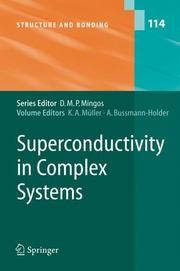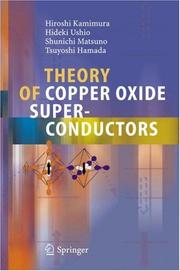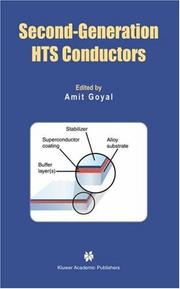| Listing 1 - 4 of 4 |
Sort by
|

ISBN: 9783540231240 3540231242 3540314997 Year: 2005 Publisher: Berlin, Heidelberg : Springer Berlin Heidelberg : Imprint: Springer,
Abstract | Keywords | Export | Availability | Bookmark
 Loading...
Loading...Choose an application
- Reference Manager
- EndNote
- RefWorks (Direct export to RefWorks)
Superconductivity. --- High temperature superconductors. --- Supraconductivité --- Supraconducteurs à hautes températures --- Chemistry. --- Chemistry, inorganic. --- Inorganic Chemistry. --- Superconductivity, Superfluidity, Quantum Fluids. --- Superconductivity --- High temperature superconductors --- Inorganic Chemistry --- Physical & Theoretical Chemistry --- Chemistry --- Physical Sciences & Mathematics --- Inorganic chemistry --- Inorganic chemistry. --- Superconductors. --- Strongly Correlated Systems, Superconductivity. --- Electric conductivity --- Critical currents --- Superfluidity --- Physical sciences --- Superconducting materials --- Superconductive devices --- Cryoelectronics --- Electronics --- Solid state electronics --- Inorganic compounds --- Materials
Book
ISBN: 0780393481 1509097023 Year: 2005 Publisher: [Place of publication not identified] IEEE
Abstract | Keywords | Export | Availability | Bookmark
 Loading...
Loading...Choose an application
- Reference Manager
- EndNote
- RefWorks (Direct export to RefWorks)
Millimeter wave devices --- Infrared technology --- Far infrared lasers --- Free electron lasers --- High temperature superconductors --- Engineering & Applied Sciences --- Applied Physics --- Far infra-red lasers --- Far infrared masers --- Infrared sources --- Lasers

ISBN: 1280262664 9786610262663 3540276327 3540251898 3642064345 Year: 2005 Publisher: Berlin ; New York, N.Y. : Springer,
Abstract | Keywords | Export | Availability | Bookmark
 Loading...
Loading...Choose an application
- Reference Manager
- EndNote
- RefWorks (Direct export to RefWorks)
This is an advanced textbook for graduate students and researchers wishing to learn about high temperature superconductivity in copper oxides, in particular the Kamimura-Suwa (K-S) model. Because a number of models have been proposed since the discovery of high temperature superconductivity by Bednorz and Müller in 1986, the book first explains briefly the historical development that led to the K-S model. It then focuses on the physical background necessary to understand the K-S model and on the basic principles behind various physical phenomena such as electronic structures, electrical, thermal and optical properties, and the mechanism of high temperature superconductivity.
Copper oxide superconductors. --- High temperature superconductors. --- High temperature superconductivity. --- High critical temperature superconductivity --- High Tc superconductivity --- Superconductivity --- Materials at low temperatures --- Superconductors --- Physics. --- Superconductivity. --- Superconductors. --- Strongly Correlated Systems, Superconductivity. --- Superconducting materials --- Superconductive devices --- Cryoelectronics --- Electronics --- Solid state electronics --- Electric conductivity --- Critical currents --- Superfluidity --- Natural philosophy --- Philosophy, Natural --- Physical sciences --- Dynamics --- Materials

ISBN: 9781402081170 1402081170 1441954783 9786610612857 1402081189 1280612851 0387258396 Year: 2005 Publisher: Boston : Kluwer Academic Publishers,
Abstract | Keywords | Export | Availability | Bookmark
 Loading...
Loading...Choose an application
- Reference Manager
- EndNote
- RefWorks (Direct export to RefWorks)
The discovery of high temperature superconductors (HTS) in 1986 by two IBM scientists led to an unprecedented explosion of research and development efforts world-wide because of the significant potential for practical applications offered by these materials. However, the early euphoria created by the exciting prospects was dampened by the daunting task of fabricating these materials into useful forms with acceptable superconducting properties. Progress towards this goal has been hindered by many intrinsic materials problems, such as weak-links, flux-creep, and poor mechanical properties.
High temperature superconductors. --- Supraconducteurs à hautes températures --- Electrical Engineering --- Engineering - General --- Electrical & Computer Engineering --- Engineering & Applied Sciences --- Engineering. --- Physics. --- Magnetism. --- Magnetic materials. --- Materials science. --- Engineering, general. --- Characterization and Evaluation of Materials. --- Theoretical, Mathematical and Computational Physics. --- Magnetism, Magnetic Materials. --- Surfaces (Physics). --- Physics --- Surface chemistry --- Surfaces (Technology) --- Mathematical physics --- Electricity --- Magnetics --- Construction --- Industrial arts --- Technology --- Mathematical physics. --- Physical mathematics --- Material science --- Physical sciences --- Materials --- Mathematics --- Superconductors.
| Listing 1 - 4 of 4 |
Sort by
|

 Search
Search Feedback
Feedback About UniCat
About UniCat  Help
Help News
News